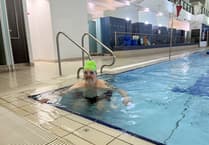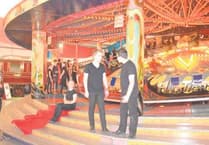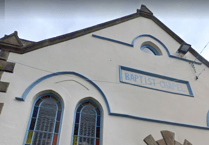A TEA party held in Tavistock Council Chamber last week saw the Mayor of Tavistock, Councillor Sue Bailey, receive a portrait of Arthur Southcombe-Parker, Fellow of the Royal Institute of British Architects — architect of the last major project to improve the town under the patronage of the Dukes of Bedford.
In 1890 Drake Road was cut through the north side of Bedford Square to provide access to the recently opened railway station. The Constitutional Club, in the corner block that now houses HSBC, was the first of the magnificent new buildings to be constructed (1895-6). Next, up the hill, were the impressive offices for the newly-formed Urban District Council, which opened in 1900.
They retain many of the architect’s original features and fittings, making the Council Chamber on the first floor the ideal venue for the Mayor to receive his portrait. The portrait was presented to mark the 150th anniversary of the architect’s birth in 1865 by his granddaughter, Mrs Jill Cutts, who lives in Tavistock. The event was attended by two further generations of the family — great granddaughter Susan Vallins of Plymouth and great-great grandson Mark Vallins and his wife Emma, who travelled from their home in Godalming.
Also present were Karen Woodward and Brian Fyfield-Shayler, representing Kingdon House, which was designed in 1906 by Arthur Southcombe-Parker to house the Tavistock Gazette offices and printing company. The building is a rare example of industrial/commercial premises in the arts and crafts style and was a key element in the overall plan for the area.
The newspaper had long occupied an old building on the western corner of Bedford Square and Drake Road, and this could not be demolished until alternative premises were found for the massive printing presses.
The only available town-centre site, at the junction of North Street and Plym Street, was cramped and awkwardly sloping, calling for great ingenuity on the part of the architect. Once the machines had been removed and the old building demolished, Southcombe-Parker’s ambitious plans for the impressive corner block which now houses TSB, Lloyds apartments and Elford Fine Arts went ahead. It was completed in 1909.
As a trustee of Kingdon House, Brian has been researching its history, and the life and other works of its architect. It was a Times article by him last October that first attracted Mrs Cutts’ attention and prompted her to make contact. Since then her grandson Mark has provided a lot of information from family papers and Kingdon House’s present architect Stephen Whettem, has sourced further data from RIBA and the British Architectural Library.
Arthur Southcombe- Parker’s later work in Tavistock included Browne’s Memorial Bungalows (1914) next to the hospital in Launceston Road, buildings for the Territorial Army and Tavistock District Laundry in Parkwood Road (since demolished).
At Kelly College he added a substantial science block (1936) to the rear of existing buildings and a new pavilion (1938).
The vicarages at Peter Tavy, Horrabridge and Yelverton are his and he was responsible for the restorations at St. Andrew’s church, Buckland Monachorum and the church tower at Walkhampton.
In Plymouth he worked on the restoration of the Prysten House and the construction of Abbey Hall nearby. He was instrumental in saving from demolition the Elizabethan House in New Street on the Barbican and was a founder and later president of the Old Plymouth Society.
Sadly, most of his new-build work in the city centre was destroyed in the Second World War and his own home in Endsleigh Place was badly shaken. He died in April 1945, just before the end of the war.
It is therefore in Tavistock that we find his finest achievement and most lasting memorial, still standing more than a century later, virtually unchanged – his group of buildings, then as new banks and council offices, vital to the life of the town – and tucked away just behind them his custom-built printing works now transformed into a thriving centre for the arts and community use, Kingdon House.



